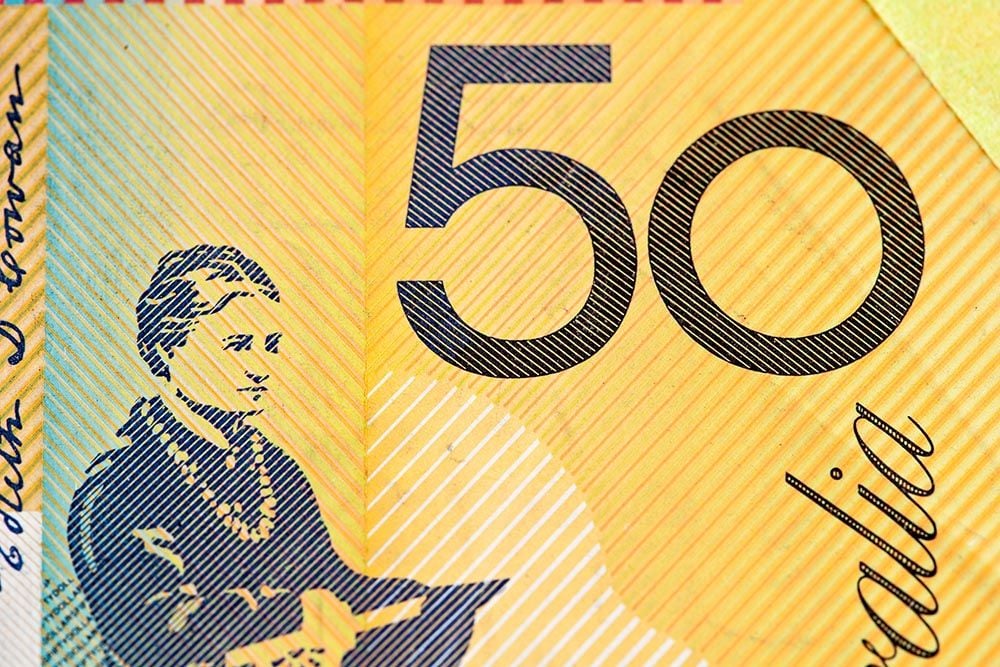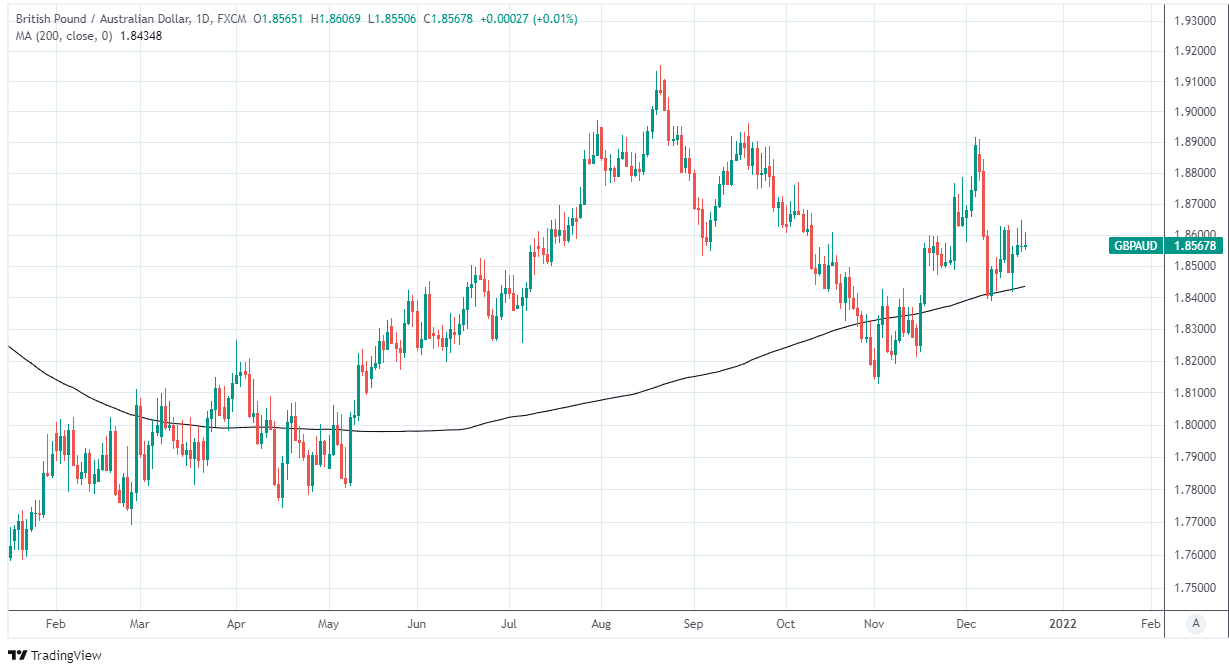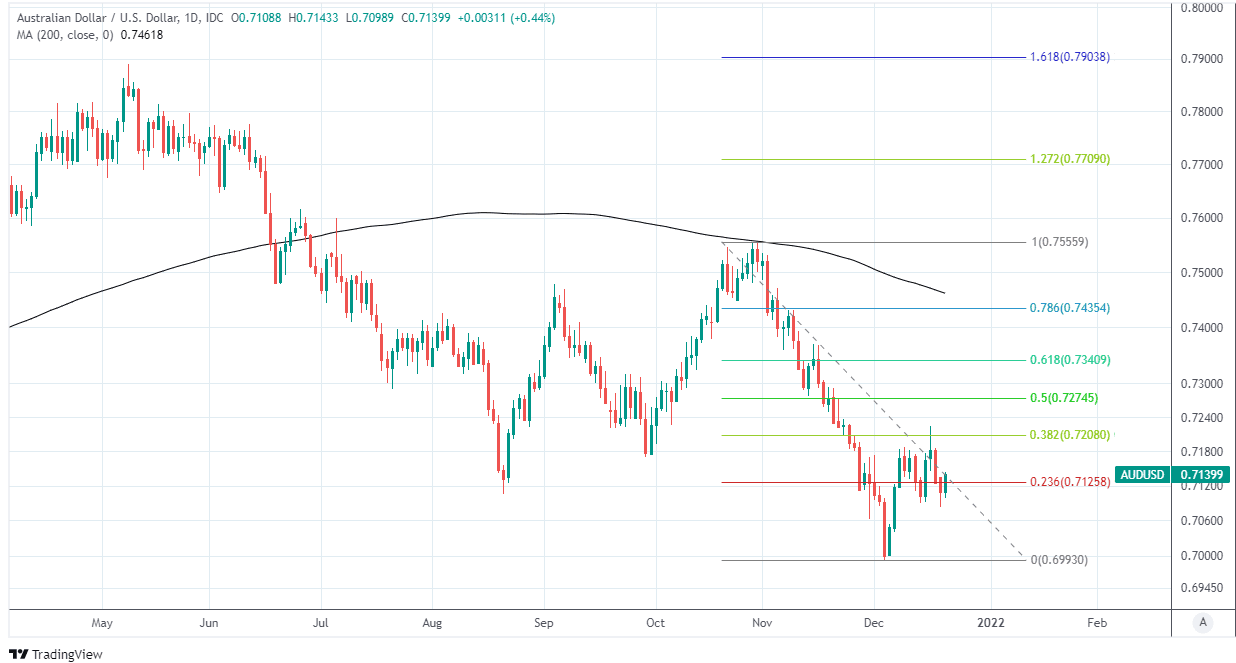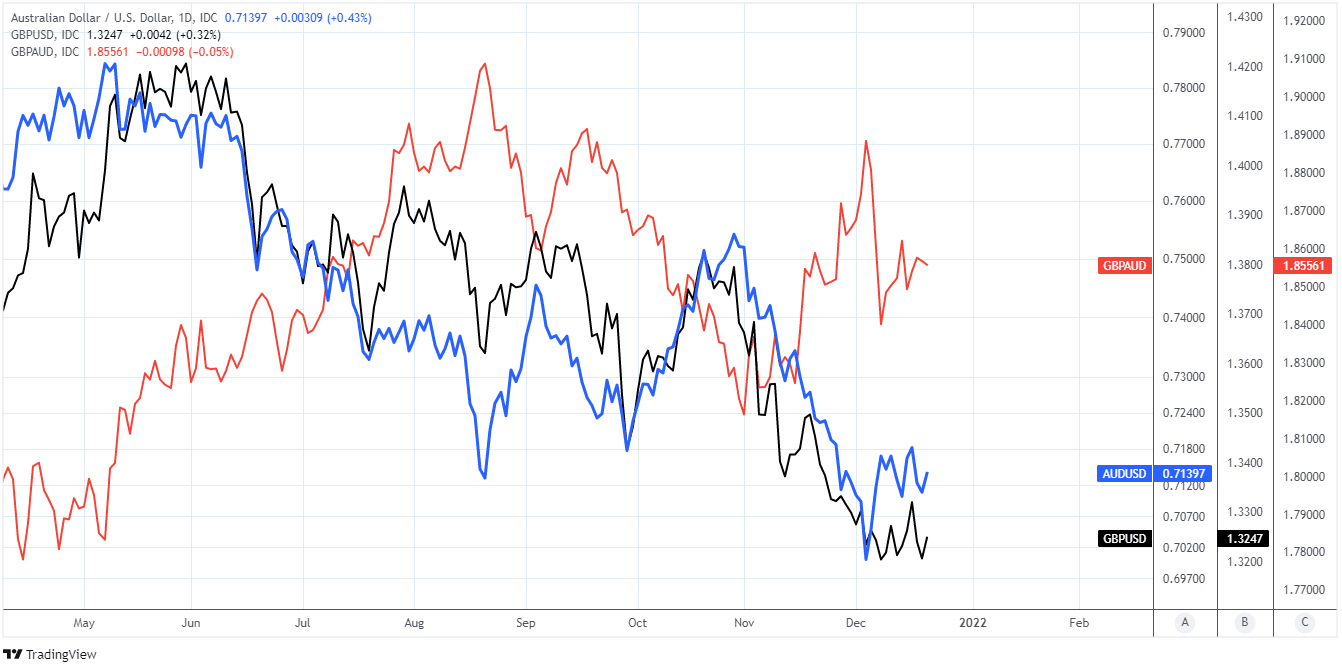Pound / Australian Dollar Rate Could Struggle if AUD/USD Recovery Continues
- Written by: Gary Howes
- GBP/AUD building support at 1.84, could edge higher
- As AUD/USD stalls, looks to consolidate into new year
- Auguring 1.84-to-1.86 GBP/AUD range for short-term
- But AUD/USD's rebound a downside risk for New Year

Image © Adobe Stock
The Pound to Australian Dollar exchange rate has begun to establish a foothold above 1.84 ahead of year-end but the outlook for it will be determined over the coming weeks by whether the influential AUD/USD rate is able to further its December rebound.
Sterling reached highs of 1.89 against the Aussie in December following a month-long rebound from November lows near 1.81, although a returning bid for the antipodean currency has since forced GBP/AUD into retreat.
GBP/AUD declines recently petered near 1.84, which could now be shaping up as a short-term support level for Sterling, although the outlook will be heavily influenced by whether this month's rebound in the main Aussie exchange rate AUD/USD continues in the new year.
“China’s latest efforts (including a surprising PBOC loan prime rate cut) to support the domestic economy have turned the narrative to a more supportive one for China-sensitive currencies like AUD. In the commodities sector, latest developments in China are fuelling a rally in iron ore, as hopes that steel restrictions will be eased seem to be brightening the demand outlook,” says Francesco Pesole, a strategist at ING.
“We think all this can help shield the Aussie dollar – which is also looking at an overstretched net-short positioning – from the blows to global risk sentiment caused by the Omicron variant spread. AUD/USD may find some good support at 0.7100,” Pesole said in a note this week.
Above: Pound-Australian Dollar rate shown at daily intervals with 200-day moving-average.
- GBP/AUD reference rates at publication:
Spot: 1.8589 - High street bank rates (indicative band): 1.7938-1.8069
- Payment specialist rates (indicative band): 1.8460-1.8490
- Find out about specialist rates, here
- Set up an exchange rate alert, here
Australia’s Dollar had probed briefly below 0.70 around the turn of the month before staging a recovery back to 0.72 last week, aided by monetary policy decisions from the Reserve Bank of Australia (RBA) and Peoples’ Bank of China (PBoC) among others.
Monday’s decision by the Peoples’ Bank of China (PBoC) to cut its benchmark loan prime rate by 5 basis points to 2.8% may have seemed like a token decision to many but was the third step in as many weeks to support the world’s second largest economy following a year of slowing growth.
Analysts cite these steps as supportive of other regional currencies and economies, although the Aussie has also recently been lifted by an emerging shift in the position of the RBA, which could potentially be on course to end its A$4BN per week quantitative easing programme in February.
“Bottom line: RBA and Fed policy dynamics will no longer be a drag on AUD/USD over the course of next year,” says Elias Haddad, a strategist at Commonwealth Bank of Australia, in a note following the release of the RBA’s minutes on Tuesday.
Minutes of the RBA’s December board meeting confirmed on Tuesday this week what was already set out by Governor Philip Lowe in an address to the CPA Australia Riverina Forum last Wednesday, which is that the bank will choose between three options in relation to its QE programme in February.
{wbamp-hide start}
{wbamp-hide end}{wbamp-show start}{wbamp-show end}
These include leaving the programme to continue buying Aussie government bonds at an unchanged pace of A$4BN per week, reducing purchases slightly or curtailing the programme in its entirety, although recent economic data may have just made the latter choice the most likely.
“The Governor has indicated on a number of occasions that he would look through higher inflation as not being sustainable unless wages growth was printing 3%. His ideal steady state configuration would be 2.5% inflation; 4% wages growth, supported by 1.5% productivity growth,” says Bill Evans, chief economist at Investec, writing in a review of minutes from the RBA’s December meeting.
“Surprisingly the Bank’s liaison program suggested that firms were generally expecting wage increases over the coming year of around 2.5%, which is broadly in line with their assessments of unions’ expectations,” Westpac’s Evans also said in Tuesday’s commentary.
While trends in wage growth, inflation and the RBA’s own forecasts suggest it could be among the last central banks in the G10 contingent of major economies to lift its interest rate coming out of the crisis, recent employment and GDP data suggests the QE programme may be scrapped promptly.
This is after November’s employment data revealed last week that a blockbuster 366.1k increase in the number of jobs created or recovered from the coronavirus, which followed other figures confirming the economy shrank by less than many expected under its latest ‘lockdown’ in the third quarter.
Above: AUD/USD at daily intervals with 200-day average and Fibonacci retracements of October fall indicating likely areas of technical resistance.
Secure a retail exchange rate that is between 3-5% stronger than offered by leading banks, learn more.
“There are two key economic publications to come before the February 2022 Board meeting that will feed into the RBA’s decision on the bond buying program: (i) the December labour force survey (due 20 January); and (ii) the Q4 21 CPI (due 25 January),” says Gareth Aird, head of Australian economics at Commonwealth Bank of Australia, in a note following the release of the RBA’s minutes.
“We expect both pieces of data to print stronger than the RBA’s forecasts from the November 2021 Statement on Monetary Policy. That is, the data will indeed indicate that ‘better‑than‑expected progress towards the Board's goals’ has been made. As a result, we shift our call on the RBA’s bond buying program to them announcing at the February Board meeting an end to purchases altogether in mid‑February,” Aird and colleagues said on Tuesday.
Local economists now expect December’s jobs and inflation data to confirm the labour market has recovered robustly from the latest round of restrictions on business activity and social contact, and that inflation pressures are beginning to build down under, which could mean the RBA feels able to justify ending its bond buying programme completely at its next board meeting in February.
Should such expectations become mainstream they could potentially help to support the AUD/USD rate once into the new year, which would then be likely to impose a further limit on the Pound-Australian Dollar rate.
The Pound-to-Australian Dollar rate could be likely to trade within a rough 1.84-to-1.86 range through the holiday period if the main Aussie pair AUD/USD holds below its recent high near 0.72, although Sterling would be vulnerable to any further attempted recovery by AUD/USD.
Any return toward November’s lows near 0.70, on the other hand, or resumption of the downtrend would likely catalyze a fresh advance by GBP/AUD.
Above: GBP/USD, AUD/USD, and GBP/AUD shown at daily intervals.








